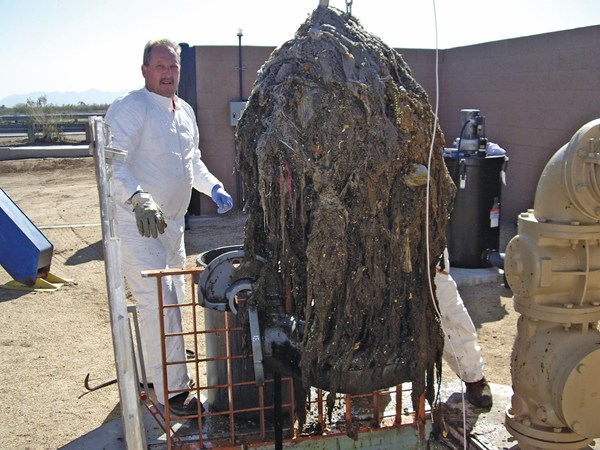The Wipes Problem Isn’t Going Away. Time to Fight Back Again?
Coverage of the wipes issue is supported by Aqualitec.

Problems with wet wipes are global (l-r): photos from Seattle, Australia and the UK.
Ten years have passed since the fierce battle began to wipe out sewer clogging wipes. How close are we to a solution?
Sadly, not close.
Mainstream wet wipes were introduced in the early 2000s for cleaning and as a “flushable” wipe. They’ve become a major challenge for sewer districts around the world. The squares of wet, stretchy paper don’t breakdown and wrap together to form long “mop heads” that quickly clog sewer pumps, check valves and screens at te treatment plants. Baby wipes made from a stretchy, spunlace plastic material are nicknamed the “pump killers” since they can quickly bind them.
Some public works crews are unclogging wipes from sewer pumps on a daily basis. A crew has to go out to clean a pump every day. NACWA estimates agencies are spending $500m to $1 billion a year clearing wipes out of their systems.
That’s not the way the sewer system was designed to work. It’s not a solid waste conveyance system. Sewer pumps should require daily cleaning by hand.

Here’s an update on wipes news:
- September 2016 – A joint effort between wastewater association and wipes makers to create an ISO standard for flushable wipes is halted after companies who manage the ISO standard for toilet paper object to a new standard for flushable wipes. ISO drops the process.
- September 2016 – WEF joins a global coalition of 244 cities and 69 water associations to release a joint statement on “flushable” and non-flushable wipes. The associations ask people to stop flushing wipes “to prevent problems with sewers, pipe and toilet blockages plus the human and environmental cost of sewer flooding and pollution.”
- Dec 2016 – The District of Columbia Council (Washington D.C.) passes the Nonwoven Disposable Products Act which requires wipes makers to meet the District’s new dispersibility criteria before they can label wipes as flushable. It also calls for a prominent “Mr No Flush” label on all packets of non-flushable wet wipes. The law is currently tied up in court by Kimberly Clark. A judge will rule in the next few days on whether DC’s new wipes law can go into affect on January 1, 2018 as scheduled.
- February 2017 – WEF and INDA (association of wipes manufacturers) release a joint Code of Practice for wipes manufacturers. The Code requires a large “Mr. No Flush” icon on any non-flushable packaged wet wipes. The wastewater sector raises concerns the no flush logo is not prominent and frequently hidden behind packaging flaps. WEF and INDA decide they are unable to continue working together and terminated the partnership this year.
- Oct 2017 – Wipes manufacturer NicePak provides a presentation about flushable and non-flushable wipes for the Bay Area Pollution Prevention Group.
- Nov 2017 – The Australian Competition and Consumer Commission has sued wipes makers over their consumer advertising. The Commission alleges the companies made “false or misleading representations in relation to ‘flushable’ wipes which they marketed and supplied in Australia.” The case is pending.
- Dec 2017 – The Water UK trade association releases a study which finds wipes make up 93% of material blocking sewers. They also report UK water utilities are spending $133 million a year clearing wipes out of the sewers. EDANA, the European wipes manufacturers associations, helped fund the study and is assisting the utilities with public outreach on what to flush.
A California meeting is coming up that will address wipes during a session:
- CASA’s Winter Conference, Jan. 24-26 in Palm Springs – A Non-Flushables Panel Discussion featuring Jennifer Cabral, OCSD; Cynthia Finley, NACWA; and Adam Link, CASA.
What is your experience with wipes? How would you stop the onslaught of wipes clogging our sewer systems? Tell us in the comments below.
